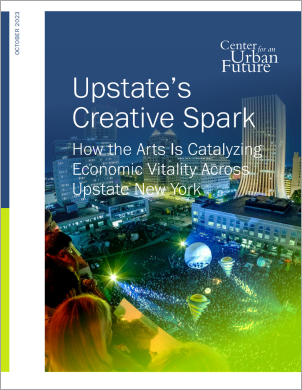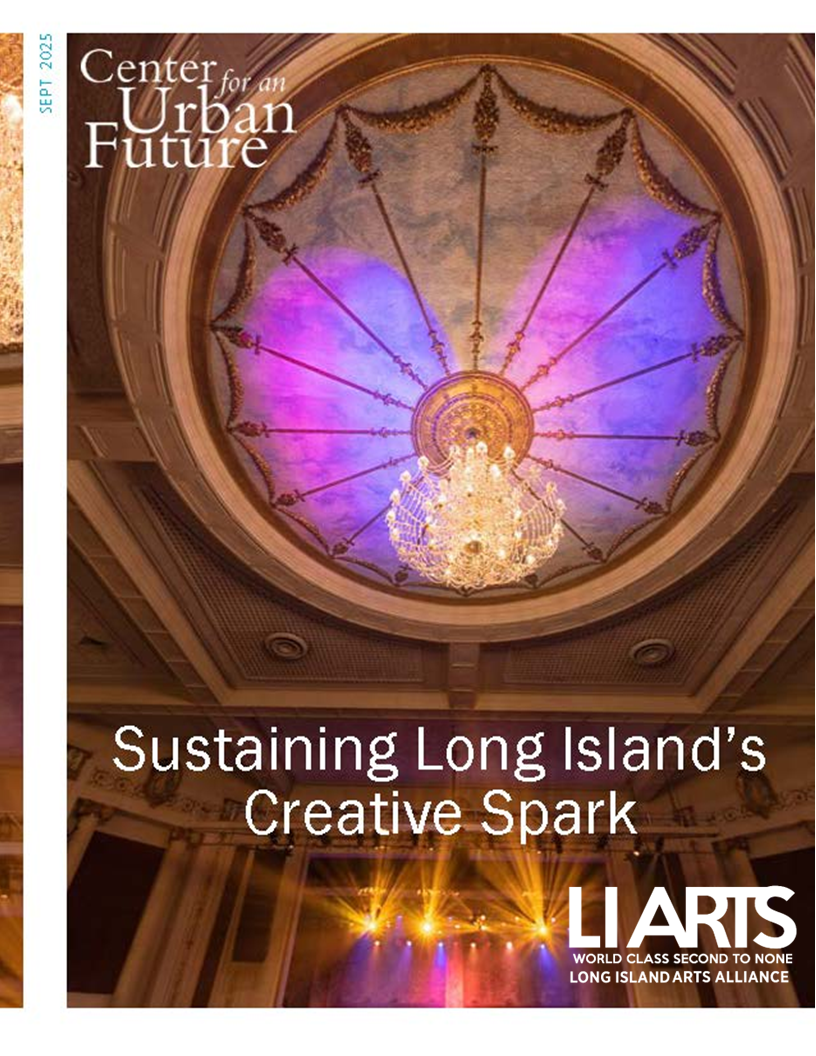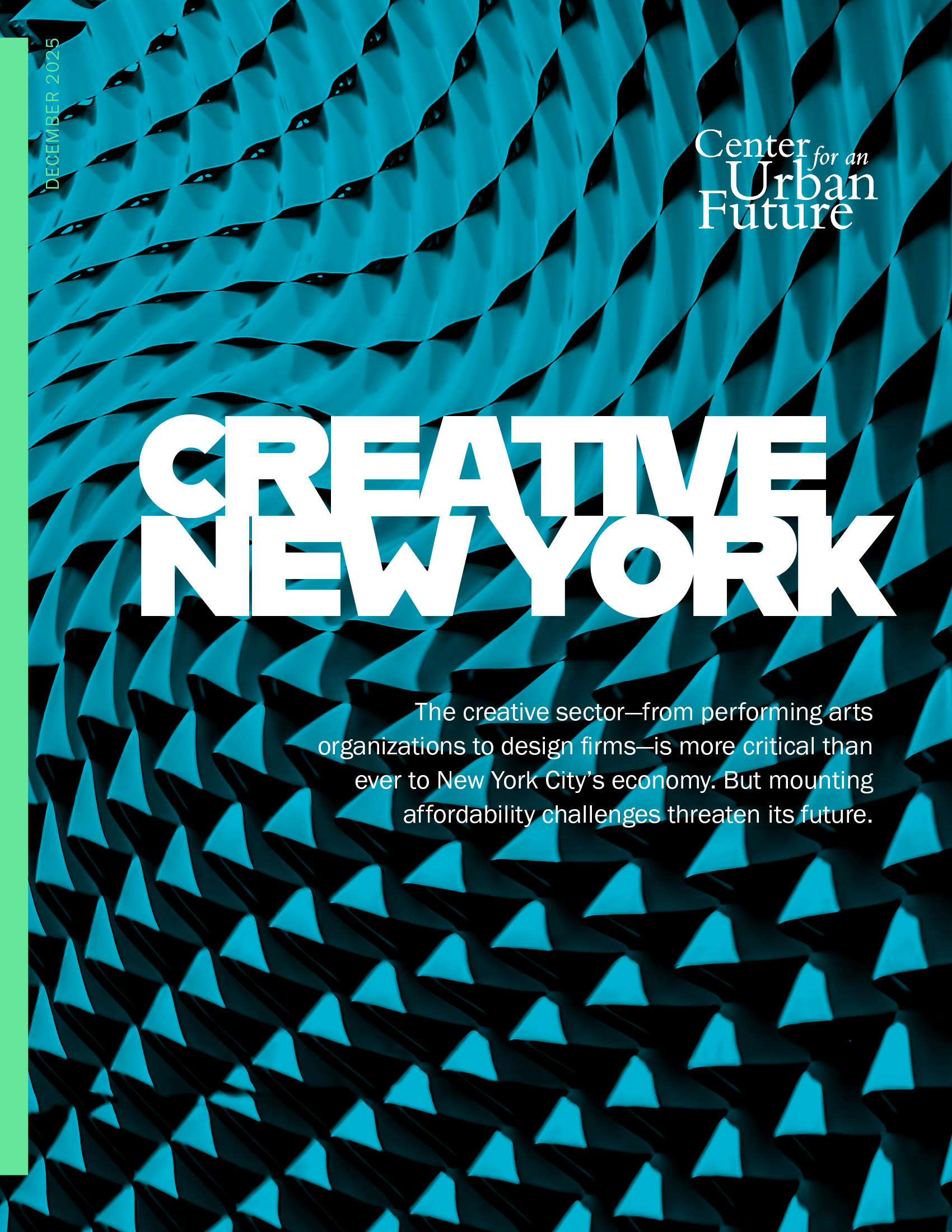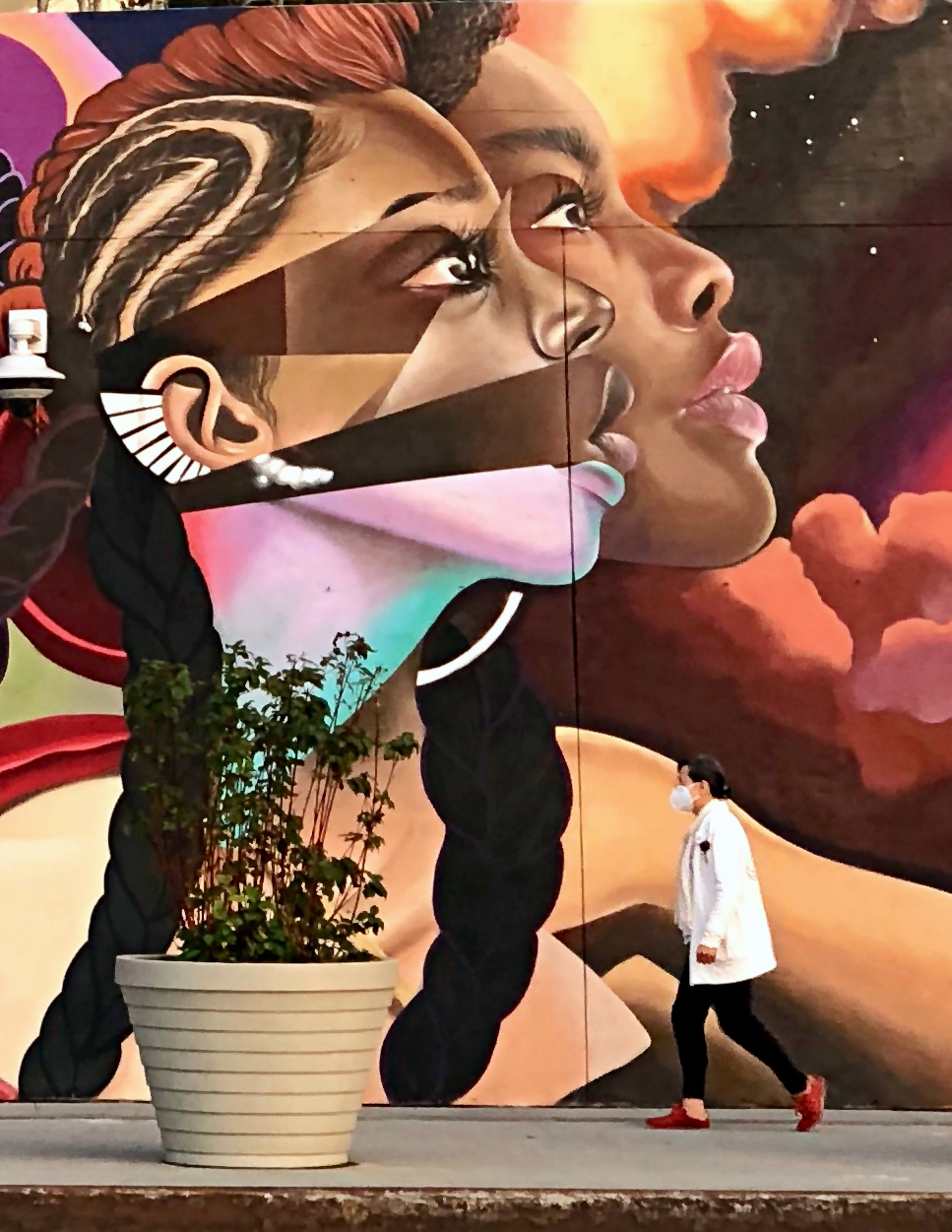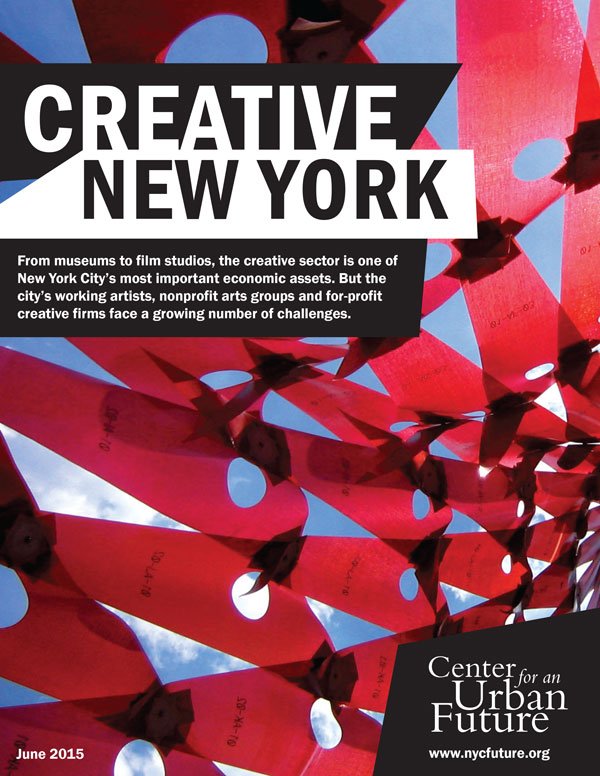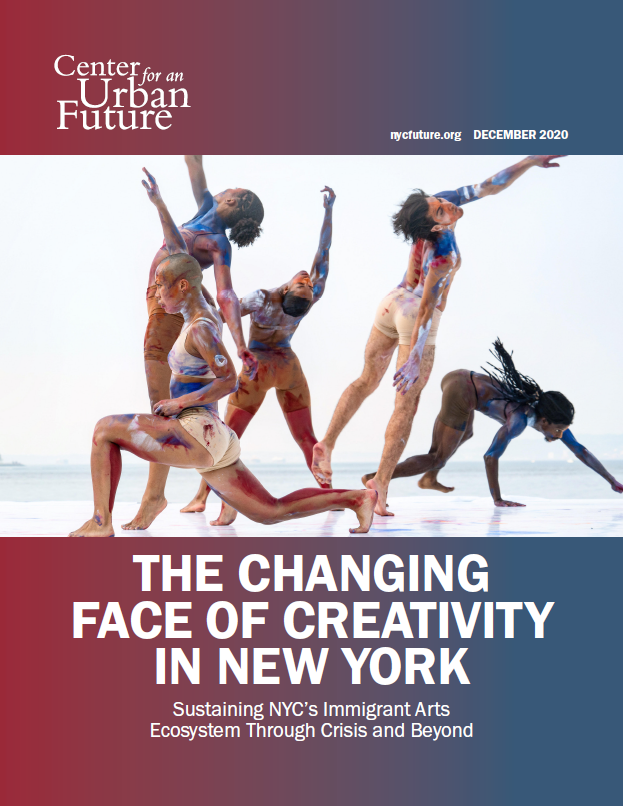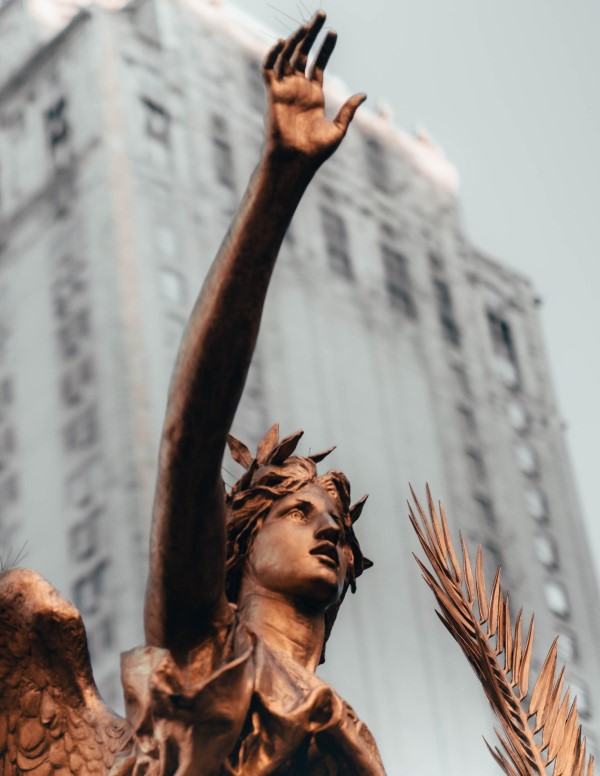Recommendations: Boosting the Upstate Arts Sector as a Catalyst for a Stronger New York
1. Make the arts and culture sector a centerpiece of statewide economic development planning. Upstate New York’s vibrant arts and culture sector has become a growing catalyst for economic opportunity over the past decade—outpacing overall employment growth by a factor of ten, reversing years of population declines, fostering new investment in hard-hit downtown areas, and serving as a beacon for local talent. However, arts and culture investments to date have formed just a small fraction of the state’s economic development portfolio, including just 3.7 percent of REDC-funded projects in 2021. New York State should make the arts and culture sector a centerpiece of inclusive economic development planning going forward and take steps to ensure that the arts sector has a seat at the table. Governor Hochul and the State Legislature should invest $500 million over five years in economic development initiatives that leverage the arts and culture sector to spur inclusive economic opportunities (without drawing from NYSCA’s limited grantmaking budget); ensure that at least 15 percent of each REDC’s membership is comprised of leaders from the arts and culture sector; work with local partners to increase the share of Downtown Revitalization Initiative projects focused on the arts and culture sector to at least 25 percent; and expand the Market New York program to include multiyear funding for destination marketing initiatives focused on creating arts and culture districts, supporting recurring festivals and events, and sustaining public art installations. To help deliver on this vision, the state should consider elevating NYSCA to become a cabinet-level agency.
2. Double NYSCA’s recurring grantmaking budget to $80 million annually, so that grants can keep pace with the growth of the sector alongside rising costs—and reach more small and mid-sized organizations. Operating support from the New York State Council on the Arts has been a catalyst for growing and sustaining New York’s rich array of cultural organizations for more than 60 years—providing a much-needed source of general operating support for organizations large and small, and reaching even more organizations through local regranting partners. However, state funding for NYSCA fell from $63,112,924 in FY2008 to $40,635,000 in FY2024—a 35.6 percent decline, after adjusting for inflation—and is now 68 percent below its 1990 peak. To help the Council keep pace with the growing arts and culture sector—as well as skyrocketing costs for everything from rent and wages to energy bills and health insurance—Governor Hochul and the State Legislature should double NYSCA’s grantmaking budget to $80 million annually, and then index future increases to inflation to ensure that the agency does not fall behind again.
3. Invest in place-based arts infrastructure, including arts councils, arts districts, and other arts service organizations. In addition to boosting NYSCA’s grantmaking capabilities with recurring expense funding, New York State should do much more to invest in place-based support infrastructure critical to the long-term vitality of the arts and culture sector. This should include seed funding to help establish and sustain local arts districts in neighborhoods and cities across the state without arts districts today; capacity-building grants to help local arts service organizations scale their reach and impact; and support for adding a community development expert or urban planner to the staff of each regional arts council to help better integrate the arts sector into local planning.
4. Launch a new initiative to help 100 arts organizations led by and/or serving historically marginalized communities to acquire long-term affordable spaces over the next five years. For many arts organizations—especially those led by and serving communities of color—the successes of the past decade have been a double-edged sword: while the growth of the arts and culture sector has helped reverse decades of population decline and sparked new investment in hard-hit downtowns, artists and arts organizations are increasingly at risk of being priced out of their own communities. To help address this growing challenge, New York State should launch a new initiative designed to help 100 arts organizations across the state acquire long-term affordable spaces, with a focus on organizations led by and/or serving historically marginalized communities. Options include securing long-term leases for large commercial buildings and working with local partners to offer affordable and renewable sublets to artists and arts organizations; creating space for the arts in underutilized or empty state-, county-, and city-owned buildings; leveraging capital dollars to help organizations purchase buildings in need of significant renovation; and lowering interest rates for arts organizations by providing loan-loss reserves to nonprofit lenders.
5. Ensure that New York State’s ambitious housing plan includes housing for artists. In recognition of New York State’s growing housing crisis, Governor Hochul has called on the state to add 800,000 new housing units over the next 10 years, supported by more than $25 billion in new investment. To ensure that every community benefiting from new housing is able to flourish, New York State should take steps to ensure that affordable housing for artists is included as part of this vital effort. New York State Homes and Community Renewal should help counties and municipalities determine the local need for artist housing and live-work space by supporting local planning studies focused on these needs—very few of which exist today. To ensure equity in the development of artist housing, New York State should support a new initiative designed to connect housing developers with organizations led by and supporting artists of color with the goal of ensuring that underrepresented artists are prioritized in marketing and tenant selection and to facilitate agreements between nonprofit developers and arts nonprofits to help boost the supply of majority-affordable developments with an artist preference.
6. Help working artists achieve financial stability over the long-term. Even as New York’s working artists are leading the state’s overall recovery from the COVID-19 pandemic, many artists themselves have been stretched to the breaking point. To cultivate a stronger and more equitable arts and culture sector for the long term, New York State will need to address several major challenges to personal and professional sustainability. First, far too many artists and arts workers lack access to the benefits that are typically attached to full-time employment, including workers’ compensation, health insurance, and retirement savings. New York State should lay the groundwork for an expansion of access to benefits for freelance and independent workers by piloting a system of universal, portable benefits that move with arts workers from job to job. Second, artists face serious challenges getting paid on time for commissions and other projects. New York State should pass freelancer protections to ensure that independent artists are paid in a timely fashion and have recourse if they do not.
7. Develop infrastructure to provide shared “back office” services for small arts organizations—and succession planning so that organizations outlast any one leader. Many of New York State’s arts and culture organizations function with just a handful of staff, or are operated by a single individual. To help more of the state’s small arts organizations thrive, New York State should partner with counties, municipalities, professional services firms, and philanthropic foundations to create shared “back office” services that multiple organizations in a single geographic area can use. These arts admin resource centers could be in-person or virtual, and include on-demand services such as accounting, human resources, legal services, architects, grant writing, and facilities management, with each service offered at predetermined hourly rates based on retainer contracts. To further support long-term continuity for many of the state’s small arts organizations, New York should launch a succession planning program designed to ensure that organizations run by long-serving solo directors or small founding teams are able to transition into new leadership or ownership models without closing their doors.
8. Equip arts organizations with the data they need for effective advocacy and program design. For many artists and arts groups across upstate New York, the pursuit of effective advocacy has been hampered by a lack of access to high quality, consistently updated data. Governor Hochul and the State Legislature should address this gap by directing Empire State Development to develop arts and culture sector data dashboards for each region of the state, including quarterly and annual data on employment, wages, business formation, artist residency and migration patterns, cultural tourism, and other indicators. These dashboards should also provide access to major national sources of arts-related data, including Americans for the Arts’ “Arts and Economic Prosperity” data and data from SMU DataArts database.
9. Generate new, dedicated revenues for the arts at the county and city levels. Given the decline in federal funding for the arts across upstate New York, and the sharp decrease in NYSCA funding since 1990, cities and counties should pursue dedicated local revenues that are specifically allocated to support the arts. Options include enacting municipal room occupancy taxes for short-term stays, with revenues dedicated to the arts; introducing a billboard tax, modeled on a successful model in Toronto, to generate funds for public art programs; implementing a small property tax surcharge directed to support the arts, as Jersey City has done; and using land-value capture tools to direct a portion of the projected increase in tax revenue from new development to support the arts.
10. Put artists to work promoting, strengthening, and supporting their communities. New York’s working artists have an essential role to play in strengthening neighborhoods across the state—creating the conditions for economic opportunity to grow, supporting youth and community development, drawing visitors from across the region and around the world, and renewing the social fabric in the wake of the COVID-19 pandemic. To unlock the full potential of New York’s artists to make positive change in all these areas and more, New York State should pursue a set of policies designed to put artists to work in service of their communities. Ideas include leveraging public and private funds to create an ongoing New York Artist Corps designed to enlist artists in developing community-scale public art projects statewide; embedding artists in state and local government agencies, modeled on New York City’s successful Public Artist in Residence program; launching a statewide tourism marketing campaign with grants for local artists to develop innovative physical and digital artworks intended to showcase their home regions; and allocating funding for artists as part of state RFPs focused on a broad array of policy challenges, from bolstering public health, conducting effective community outreach around new programs and benefits, and combating the state’s mental health crisis, to supporting recent immigrants and asylum-seekers, addressing gun violence, and improving traffic safety. On all these issues and more, artists are uniquely well positioned to help New York make progress—but are too often left out of the solution.

